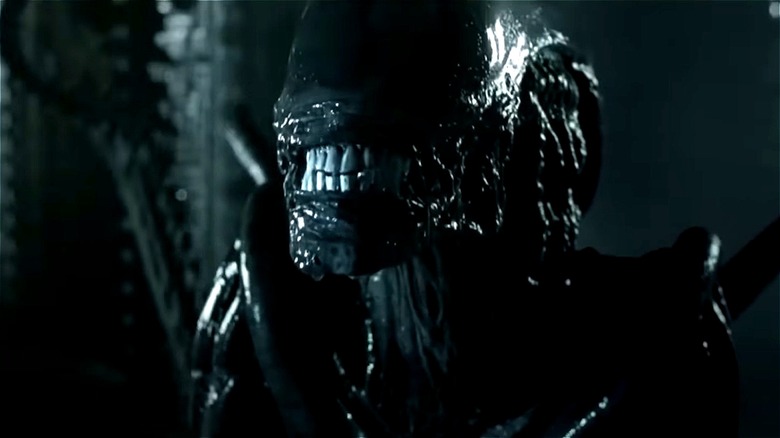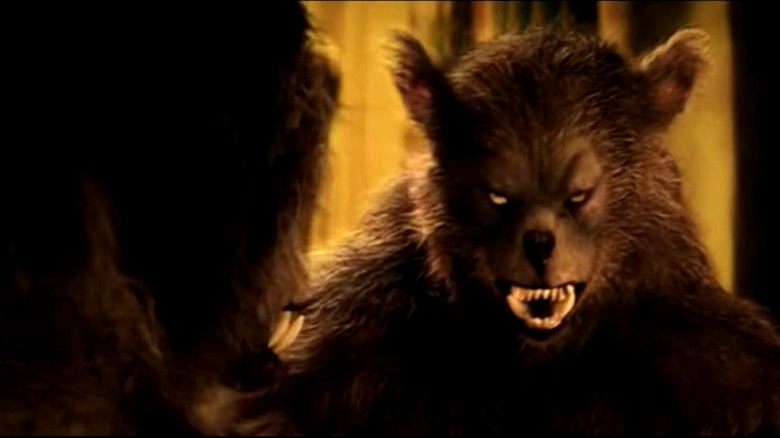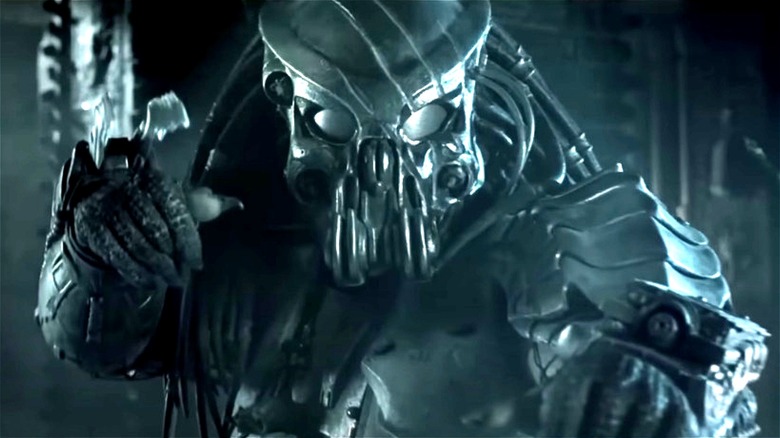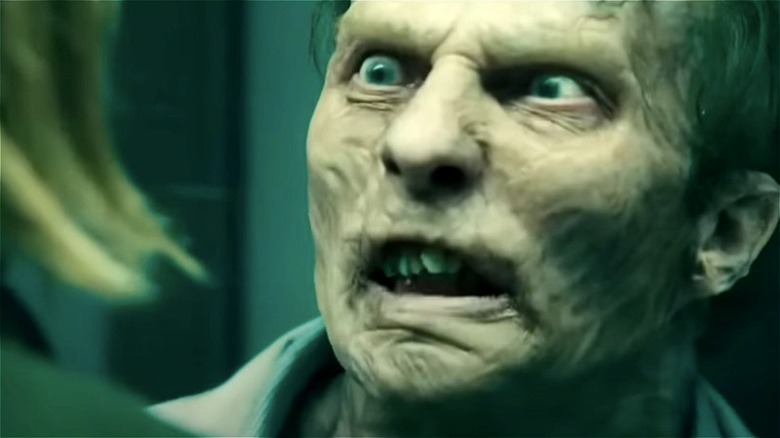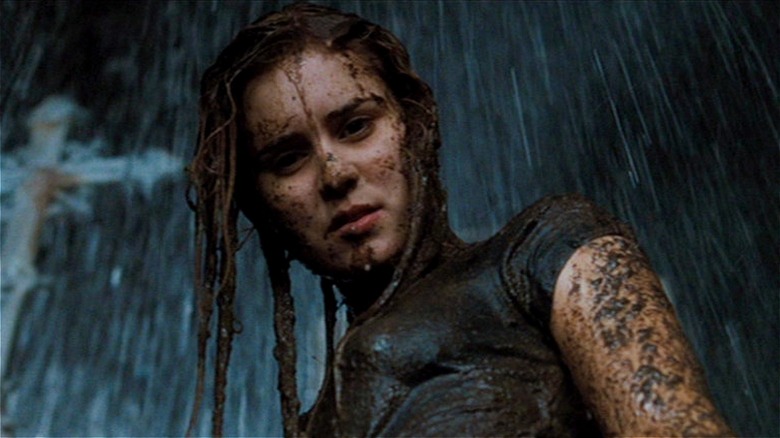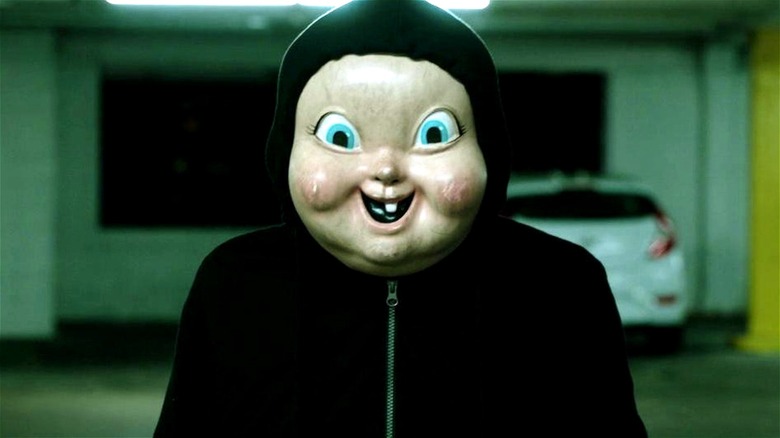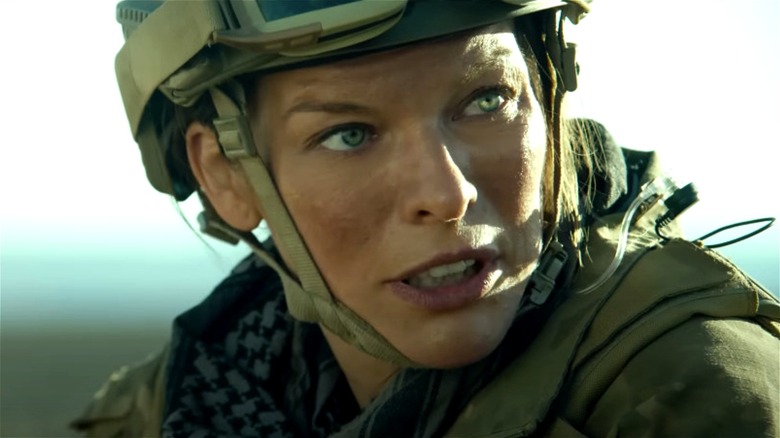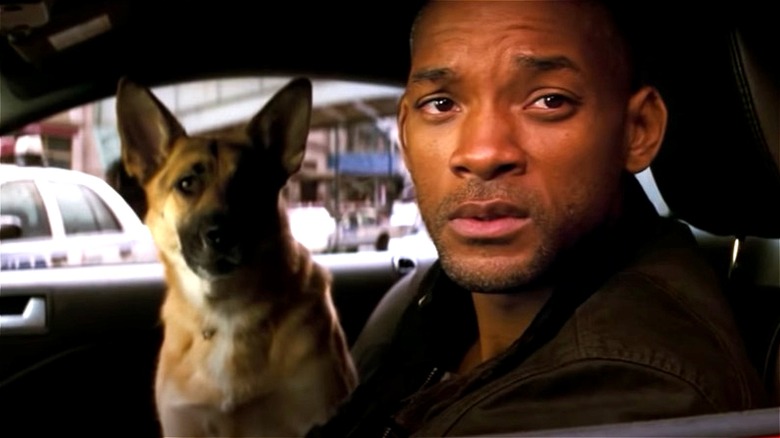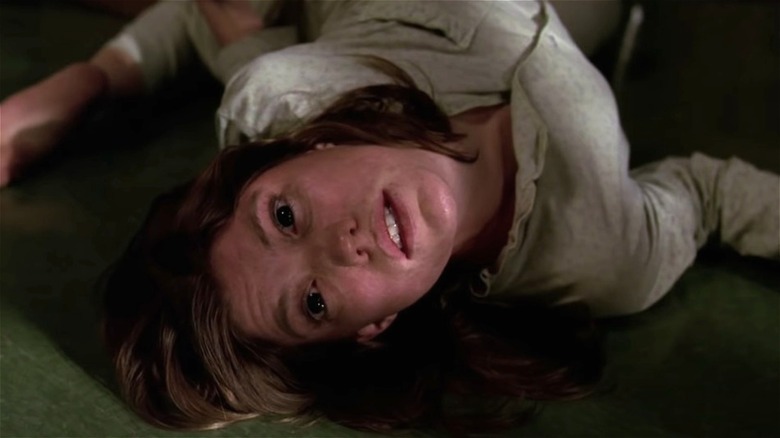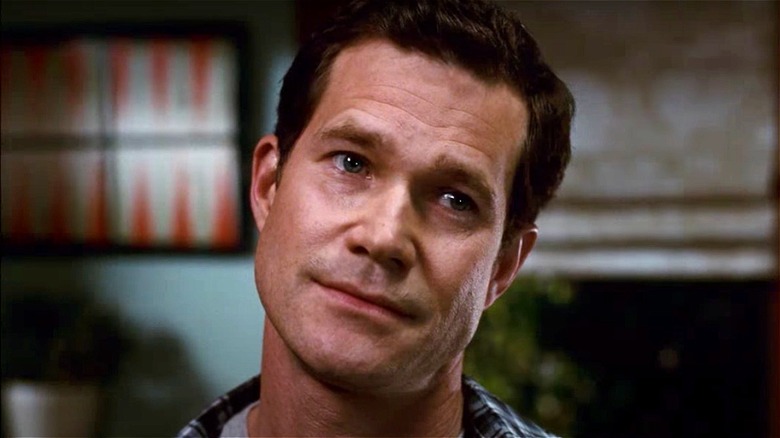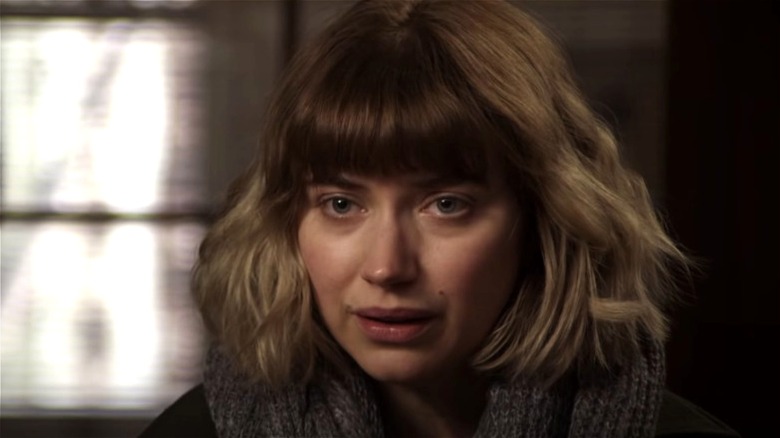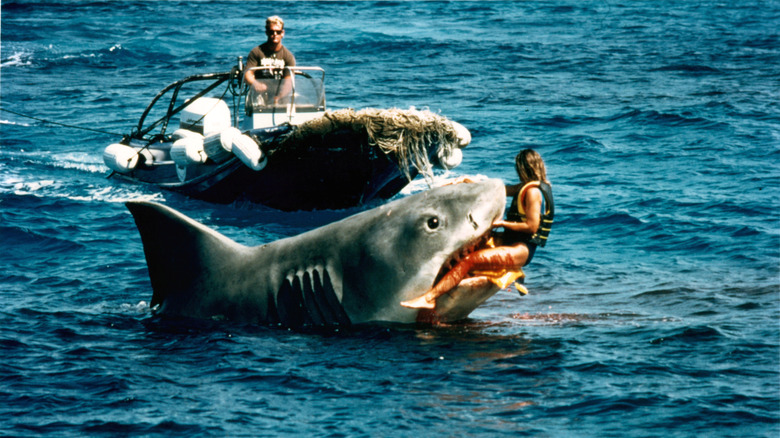Horror Movies That Should've Been Rated R
In World Wrestling Entertainment, the period from July 22, 2008, to March 22, 2014, remains known as the "PG era," owing to how Vince McMahon adjusted the content to achieve a TV-PG rating after the TV-14 fare in the so-called "Attitude" and "Relentless Aggression" eras of the 1990s and early-to-mid 2000s. (via Sportscaster)
WWE had caught up with Hollywood, where a similar wave of chlorine had washed over mainstream cinema and sanitized dozens of projects including "Live Free or Die Hard," "Terminator Salvation," "Hancock," and "Fired Up." These films and many more were stripped of violence, swearing, and sexuality in order for the MPA to grant the studios a PG-13 rating and access to the lucrative teen demographic. Such money-mindedness proved bad enough for the action and comedy genres, but it was arguably even worse for horror filmmakers, who risked self-censorship unless they worked within the thriving "torture porn" fare of "Saw" and "Hostel."
The subject of violence and censorship causes us to look at ourselves. Is it wrong to enjoy cinematic violence and gore? No, violence can charge a film with tension, horror, and even humor. There's a difference between the slapstick gore in "Re-Animator," for example, and the real-world violence at home and abroad. What caused this trend in kid-glove treatment? Crime, terrorism... Janet Jackson's "wardrobe malfunction"? I'm not sure, but here are horror movies that should have been rated R.
Cursed
Excuse the pun, but Wes Craven's "Cursed" is a howlingly bad example of the PG-13 trend in the 2000s and 2010s. Take Judy Greer's werewolf transformation and compare it to the genre-defining work in "An American Werewolf in London." Instead of David Naughton's agonized performance and Rick Baker's bravura special effects (which necessitated an Oscar category), we get a vacuous display of subpar CGI with no heart or pain. Similarly, when the fighting and killing happen, there is a neutered lack of viscera.
Baker actually worked on "Cursed" for some time under the agreement that neither Bob Weinstein nor Wes Craven would opine on his creative process. However, the production soon faced difficulties. "They shut the film down and we were doing some really cool transformation stuff," Baker told Joe Rogan, "and I said 'Listen, if you ever think the film is going to pick up again, keep a number of my people on another month and we can have this transformation stuff ready to go.'" Alas, the production discarded much of Baker's work and replaced it with dreadful CGI.
Experienced MPA warrior Wes Craven shared his own account with the New York Post. "The contract called for us to make an R-rated film... then it was basically taken away from us and cut to PG-13 and ruined... the studio thought they could make more with a PG-13 movie." When "Cursed" finally opened in 2005, it grossed $29.6 million against a $38 million budget (via Box Office Mojo).
Alien vs. Predator
Numerous problems plagued "Alien vs. Predator" and its PG-13 rating was one of them. Why make a PG-13 spectacle out of two R-rated franchises? Money is the obvious answer but it doesn't entirely make sense. Every film from each series turned a profit; there was and still is an established, R-rated audience. Just look at the R-rated "Prometheus" and "Alien: Covenant." They earned $403 million and $240 million, respectively. True, they hit theaters years after "Alien vs. Predator" (even the savviest studio suit can't tell the future), but all the films of the 70s, 80s, and 90s suggested that a lucrative R-rated "Alien vs. Predator" was a sure thing.
The only explanation? That 20th Century Fox attempted to find a new and even wider generation for their intellectual property. Count me among them, sort of. The problem is that I'd seen the entire "Alien" and "Predator" franchises at a tender age, so a 100-minute display of formulaic set pieces and insipid CGI gore was not going to impress me or any other kid I knew who had seen the original films. John McTiernan may have improved its fortunes had he been in the director's chair but the studio, I suspect, would have remained committed to PG-13 dollars.
World War Z
Brad Pitt's character may cover several continents in "World War Z," but the lack of gore limits this epically staged zombie film in both its theatrical and unrated releases. The latter improves on the CGI blur audiences saw in theaters, but flashes of a bloody forearm stump are about as gruesome as the unrated cut gets. For anyone who grew up with the films of George A. Romero, "World War Z" doesn't cut it. "Dawn of the Dead" and "Day of the Dead" feature some of Tom Savini's most ingeniously brutal gore effects, and even "Night of the Living Dead," though dated, retains a bleak power and shock ending.
If Savini or one of his graduates had worked on "World War Z," the bloody stump would be in full view of a focused, deliberate camera and joined by all sorts of other bodily desecration. A zombie film without R-rated gore is like a comedy with no laughs. Still, the PG-13 cut netted $540 million for Paramount Pictures, which is significantly more than Romero's entire trilogy, unadjusted for inflation (via Box Office Mojo). However, I'm thinking many people leaving theaters would have rather watched a Romero classic or the latest episode of "The Walking Dead," which certainly does not want for R-rated content.
Drag Me To Hell
Sam Raimi always finds a way to add violent impact to his films. Just look at the ending of "Spider-Man," when Spider-Man and the Green Goblin exchange vicious body blows and throw each other through brick walls in a derelict, tetanus-ridden warehouse. It's a tangible contrast to the green screen indulgence found in contemporary comic book movies.
The "Spider-Man" climax contains trace amounts of Raimi's debut, "The Evil Dead," the shoestring budget, NC-17 masterpiece full of creepy ambiance and lumpy gore that was cut and banned around the world. "Drag Me to Hell" is gorier than anything in Raimi's "Spider-Man" trilogy, especially a scene involving a falling anvil and a woman's eyeballs. It's also a pretty accomplished little horror film with punchy B-movie thrills that hark back to Raimi's origins. However, such throwbacks cannot turn the PG-13 "Drag Me to Hell" into "The Evil Dead." A punchy little B-movie is good enough, but it's been decades since Raimi made a horror film of that boundary-pushing caliber.
Happy Death Day
"Happy Death Day" is a comedy slasher film with college students, a masked killer, and satirical self-awareness. It's a bit like "Scream" and a bit like "Groundhog Day," and it made a monumental $125 million at the box office on a budget of just $4.8 million (via Box Office Mojo), a terrific return for any film, especially a frivolous work with little suspense and few, if any, scares.
Part of the problem here? The PG-13 rating, of course. Slasher-style horror depends on strong bursts of gore but "Happy Death Day" chooses inference over impact. The killer tends to stab his victims just out of the camera's view but when we do see some open incision, there is little or no blood. There's also a baseball bat strike that is less vicious than a kids' piñata party. More convincing is a moment in which a young woman falls from a window and hits the ground with a bloody, squelchy impact.
"Stitches" rates as a better example of a comedy-slasher film. In the gross-out slapstick horror flick, a clown turns rogue after falling face-first on a carving knife protruding from a dishwasher. He manages to pull the blade out but then slips on his blood and loses the grip on his knife, which flies up in the air and lands, blade first, right back in his face. It's an extreme brand of slapstick violence that recalls the early Peter Jackson horror excursions "Bad Taste" and "Dead Alive."
Monster Hunter
Paul W. S. Anderson has his critics, but few would accuse him of skimping on gore. "Event Horizon," for instance, is replete with all kinds of fleshy madness, from blunt-force trauma to evisceration and a frenzied massacre that erupts in a blur of blood and organs. Anderson's "Resident Evil" series has its moments too, namely a sequence in which a laser cuts through a group of soldiers, slicing them at the neck, waist, and even in a grotesque lattice formation. However, you'll find none of this in the decidedly PG-13 "Monster Hunter," the director's 2020 adaptation of the popular game franchise.
Granted, the games are not violent — the monster swordplay features sparks and flashes rather than bloodletting — but that doesn't mean the film has to be such digital nonsense. Occasionally, "Monster Hunter" recalls the sandy locales of "Starship Troopers," only the monsters in that film don't just kill their victims, they tear them limb from limb. I think such viscera could have injected a bit of energy and grit into "Monster Hunter," regardless of whether it's faithful to the video game, because all the million-dollar CGI amounts to is one long, unskippable cutscene.
I Am Legend
"I Am Legend" is not without power but I believe that anything vaguely zombie-related must be a hard R. I am also of the opinion that horror films should use practical effects wherever possible, and this is where "I Am Legend" has some serious problems.
Now, there can be a slight creepiness to the Darkseekers — an aggressive breed of vampiric cannibals spawned by a mutated measles virus — but the CGI feels oddly smooth and almost PS3-tier. Instead of making the film look like a bad video game, why didn't Warner Brothers invest the enormous $150 million budget in extras and gore effects? I may sound like a curmudgeonly uncle on the subject of CGI, but numerous sequences in "I Am Legend" have aged like milk.
Again, there are strengths to "I Am Legend," namely Will Smith's performance and the eerie realization of post-apocalyptic New York but they are betrayed not only by some questionable divergences from Richard Matheson's novel but also a bloodless, digital aesthetic that assaults your eyeballs with the modish, frenzied editing style of the mid-2000s.
The Exorcism of Emily Rose
Can the devil really be PG-13? Critics didn't think so. The Rotten Tomatoes consensus explicitly called out the "gore-free scares" in what it deemed "a ho-hum take on demonic cinema." After all, any film about exorcism — and especially one that makes a titular reference to it — will be compared to "The Exorcist," known to generations as one of the scariest films ever made.
William Friedkin's horror classic earned this reputation with an uncompromising, hard-R interpretation of William Peter Blatty's novel of the same name. That means coarse language, invasive medical procedures, gruesome disfigurement, and the vicious misuse of a crucifix — all involving a 12-year-old girl. Consequently, "The Exorcist" retains the power to shock some 50 years later.
The same cannot be said of "The Exorcism of Emily Rose," which feels like a bloodless imitation packaged for a younger, wider audience. But in the case of "The Exorcist," the kids have probably heard of it.
The Stepfather (2009)
There can be no doubt that the original "Stepfather" film was made in the 1980s — the style is televisual and the synthetic score overbearing to the point of parody — but the 1987 psychological horror also offers an interesting story about a roving serial killer who preys upon single, middle-class mothers and ingratiates himself as the proverbial family man only to destroy them when his facade slips. Terry O'Quinn imbues the killer with a creepy everyman quality and the violence, though infrequent, adds a bloody edge to a disturbing premise, which was inspired by John List's 1971 family annihilation. (via AFI) Despite this, "The Stepfather" does show its age compared to "Henry: Portrait of a Serial Killer" or "The Vanishing," released in 1986 and 1988, respectively.
Unfortunately, the 2009 remake — which starred Dylan Walsh — did nothing to update the plot (in the context of the times). The Rotten Tomatoes critical consensus lamented the film's lack of "tension and satirical undercurrents," but it didn't note that "The Stepfather" was cut to PG-13 to appease the MPA and the studio. According to Movie Censorship, eight cuts were made to scenes of violence, reducing the impact of numerous scenes including an asphyxiation, a drowning, and the aftermath of a family murder. A hard R may have charged this damp squib, but the unrated home release — which restored a whole 48 seconds of footage — suggested that the remake was always going to be toothless compared to the original.
Black Christmas (2019)
The original "Black Christmas" is often recognized as the slasher film made some four years before John Carpenter's "Halloween," which kicked the door in for a raft of imitators such as "Friday the 13th," "The Burning," and "A Nightmare on Elm Street." Any true slasher fan will know this about "Black Christmas," but how many have actually seen it? I'm not sure, though I was impressed when I finally did, engrossed by its deft balance of violence and foreboding suspense (a balance that the slasher genre has struggled with ever since).
No such praise can be given to the 2019 remake, however, which shares little with the original beyond its title. Director Sophia Takal attempts to weave feminist commentary into postmodern slasher tropes that results in an uneven, often earnest, sometimes dull, and always unscary 92 minutes. Takal and her co-writer April Wolfe opted for a kind of message movie aimed at the teen female demographic, so they had to secure a PG-13 rating, which meant disarming any violent charge that could have brought this project to life. A box office gross of $18.5 million against a $5 million budget suggests that this aesthetic sacrifice did not pay off (via Box Office Mojo).
Jaws: The Revenge
Never forget the badness of "Jaws: The Revenge." After the terror of "Jaws" and "Jaws 2," Ellen Brody, now widowed, swears that another great white shark is out there harboring vengeful feelings toward her, so instead of moving to Kansas City or some other firmly inland locale, she joins her son Michael in the Bahamas, where he works as a marine biologist. Soon, Ellen's superstition proves right. The toothed beast arrives, having followed them all the way from Massachusetts.
This supernatural bent is not the only indignity thrust upon the "Jaws" franchise. Cue a showreel of hammy performances, a shark that roars like a B-movie dinosaur, and a paycheck appearance by Michael Caine, who later said, "'I have never seen it but by all accounts it is terrible. However, I have seen the house that it built and it is terrific."
Nice comeback and all is forgiven, but there was no forgiving or salvaging "Jaws: The Revenge." It was never going to be like its forebears, so why bother? Instead, why didn't director Joseph Sargent go full-blown Joe Dante, the man behind "Piranha"? Imitate the imitators — increase the blood and reduce the clothing of everyone involved. Make it the sharksploitation film that it should have been; there's more dignity in a hard-R shlockfest than a PG-13 disaster that will be mocked for eternity.
